Green is the Verde: How an Arizona river became a water conservation success story, for now
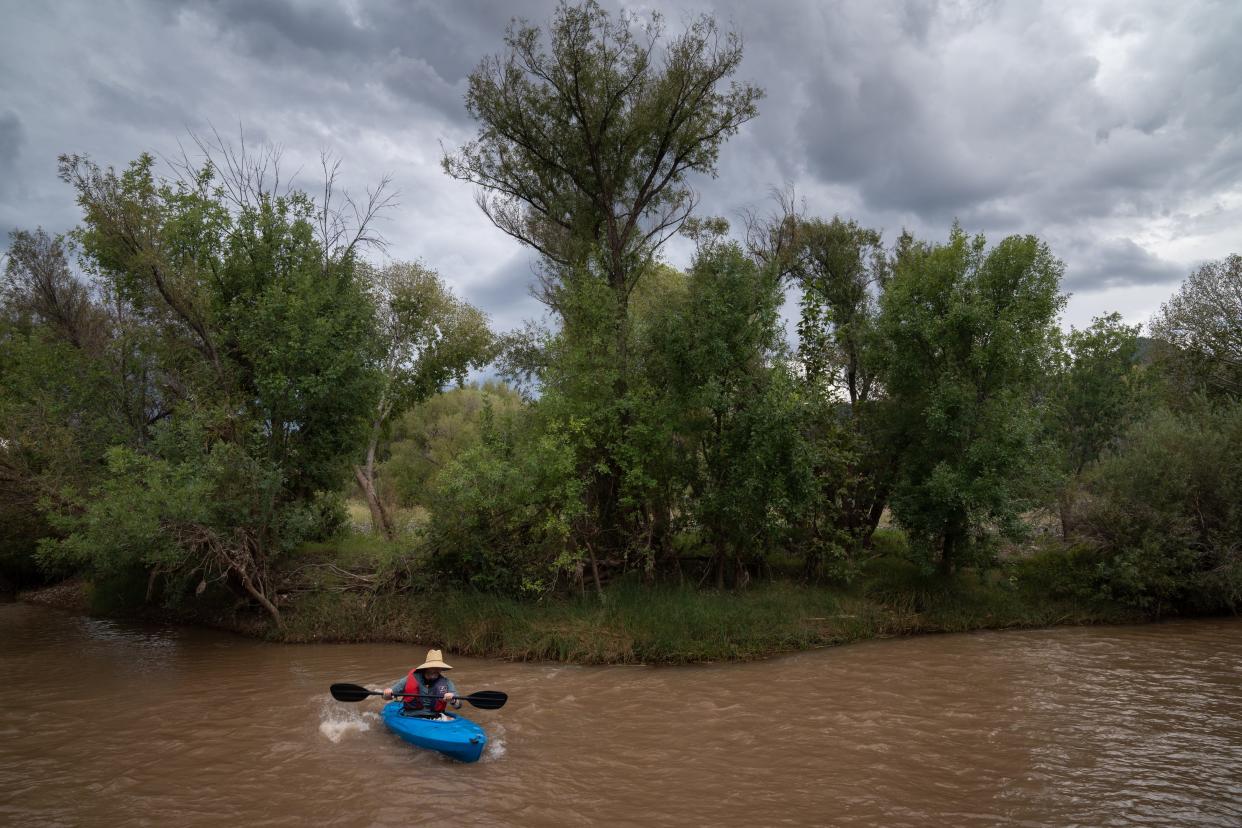
The cicadas along the river corridor through Camp Verde are deafening, possibly more so on the eastern bank. That’s where a conservation easement has protected the land from a spate of development by Phoenix residents seeking to establish riverside refuges in the higher, cooler climes a 90-minute drive north. These signature sounds of summer in wet landscapes — Arizona’s male Apache cicadas are some of nature’s loudest insects — drown out any noise from the busy interstate just a few miles away.
Claudia Hauser says she doesn’t even hear the cicadas anymore. She’s been kayaking this stretch of river for much of her adult life, whenever she can escape duties on her adjacent family farm. This warm day in early October is only the second time she’s made it out on the river this year. The first was in March, to celebrate a new easement the Nature Conservancy helped secure for a section of land a few miles downstream.
The parcel we’re passing now in a flotilla of two hard-shell kayaks and three inflatables was preserved with a conservation easement obtained by the Nature Conservancy and purchased by the Hauser family in 2018, and has helped maintain the river’s ecological balance and water flows.
By stopping the clock on the ever-quickening pace of western land conversion and protecting this section for future generations, the easement allowed Claudia and her three adult children to continue growing corn, alfalfa, sweet barley and watermelon, rather than being forced to sell to developers to eke out a living.
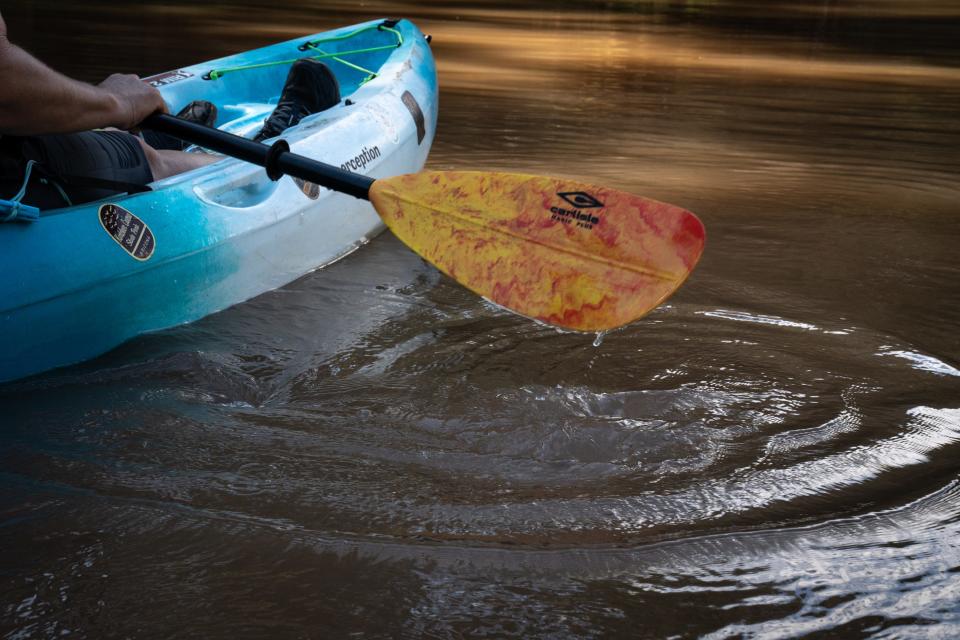
The difference is plain to see. On our left as we float downstream, large, leafy branches arch overhead, casting enough shade over the river to keep temperatures down and give desert sucker, roundtail chub, spinedace and other native fish a chance of survival when water levels drop and heat waves strike.
These “Trees-of-Heaven” are not native to Arizona, but are ecologically beneficial and now a historic part of the Verde River landscape. Claudia says they were planted by Camp Verde settlers in the mid-1900s because this pollution-hardy species, featured in the novel "A Tree Grows in Brooklyn" for this reason, could survive the toxic smelter smoke of Verde Valley copper mines.
Their golden blossoms have a “burned peanut butter” fragrance. And, along with native cottonwoods, their roots stabilize river bank soils against erosion while their canopy fosters a lush understory of willows and herbs that provide habitat for bobcats, jackrabbits, javelinas, gray fox, coyote, mountain lions and rare species of reptiles and amphibians. The Verde is also a critical flyway for migratory birds and a nesting site for bald eagles. On the east bank, that is.
On the western side, few branches remain for birds or other wildlife seeking shelter. At this part of the river, about 80 miles into its 195-mile journey from Big Chino Valley, where underground headwater springs bubble up to form surface flows, many of the trees have been felled by private builders seeking river views. Invasive Johnson grass has sprung up, dipping millions of tiny root straws into the Verde upstream of where it joins the Salt River near Phoenix and supplies up to half of the metro area's water supply, by some estimates.
Unlike Tree-of-Heaven roots, Johnson grass does little to prevent erosion, so landowners planted invasive Arundo, a giant reed similar to bamboo that has its own, larger thirsty straws, to try to hold everything in place.
When that didn’t work, property owners along the river’s western side tried driving metal I-beams into the bank to slow its disappearance. A mile into the float, their half-sunk remnants appear as eerie skeletons of failed human ecosystem dominance.
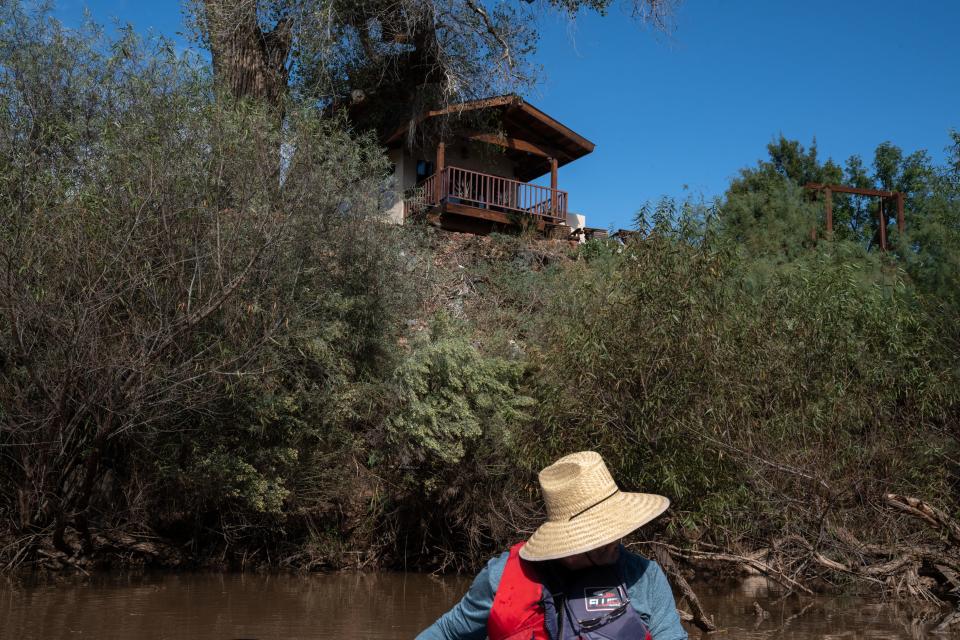
Overall, though, Arizona’s Verde River is a conservation success story, at least along this middle section. While the American Southwest struggles against the death grip of a megadrought, lackluster water conservation efforts, a growing population and unproductive negotiations over how to divide up shrinking shares of the Colorado River, the Verde — with its boisterous cicadas, active wildlife and lush vegetation — stands out as a climate change survivor.
It’s thanks to the combined and ongoing efforts of groups like the Nature Conservancy, Friends of the Verde River, the Center for Biological Diversity, the Sierra Club and environmentally-minded farm families like the Hausers.
“As we look at drought and climate, water levels are going down, temperatures are going up,” said Kimberly Schonek, our kayaking guide and the Arizona Nature Conservancy’s Verde River Project Manager. “We cannot statistically tell you that we’ve changed the flow at the gauge by this much. But 12 years ago, you couldn’t have floated this in July.”
All that could still change.
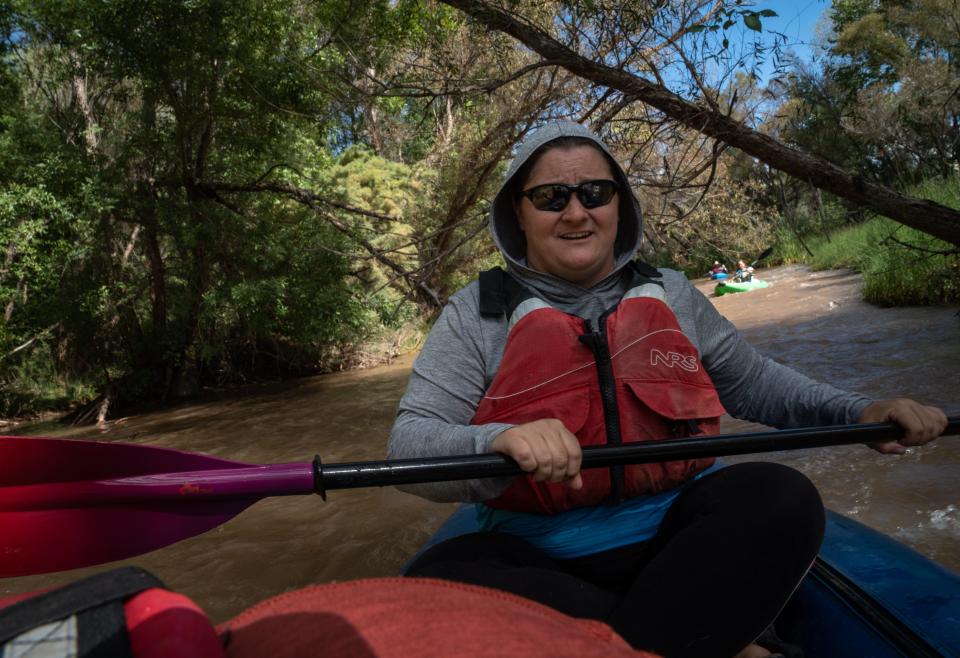
Lessons from the Hassayampa and the San Pedro
Both the Nature Conservancy and the Center for Biological Diversity have also spearheaded projects to protect Arizona’s Hassayampa River, a centerpiece of Wickenburg northwest of Phoenix, and the San Pedro River, which crosses into Arizona’s southeast corner from Mexico near Sierra Vista and flows northward to the Gila River.
The Arizona Nature Conservancy has worked with the Maricopa County Parks and Recreation Department to monitor and maintain the 770-acre Hassayampa River Preserve, a popular spot for hiking, birding and picnicking. With a past as ranch land and a stop on the Santa Fe Railroad in the early 1900s followed by conversion to a trailer park in the 1970s, the 1986 restoration and 2004 expansion of this unique desert oasis represents a vast improvement.
But the Hassayampa is not entirely safe. In June 2020, the center battled a second attempt by an India-based company, Pushpak Bullions Private Limited, to undertake a gold mining operation along the river by taking advantage of a loophole in federal mining law that allows offshore firms to pursue minerals claims after obtaining U.S. “corporate citizenship” via a locally-based subsidiary.
Environmentalists say extraction activities would further imperil sensitive species, including the protected Mexican spotted owl, lowland leopard frog, desert sucker, northern goshawk, common black hawk and western red bat. As reported by The Republic in 2020, the project would also put pressure on a rare species of agave that holds cultural significance for several Yavapai tribes and other Indigenous peoples.
Potential threat: Gold mine along Hassayampa River may imperil tribal cultural, riparian sites
A month after the nonprofit conservation organization aired its objections, the Prescott National Forest withdrew its approval of the controversial River Bend Placer Mine Project, citing a need to re-evaluate whether proposed mitigation measures would be enough to avoid significant impacts to the environment. But the fight isn’t over for the Hassayampa, which also simultaneously faces relentless threats related to climate change.
“It’s definitely a river that over time has really declined as a result of both drought and groundwater pumping,” Schonek said in a post-kayak phone call about the Hassayampa. “And that’s something where it’s going in this direction that there’s not a lot we can do to protect riparian habitat. We need a lot of funding and a lot of focus.”
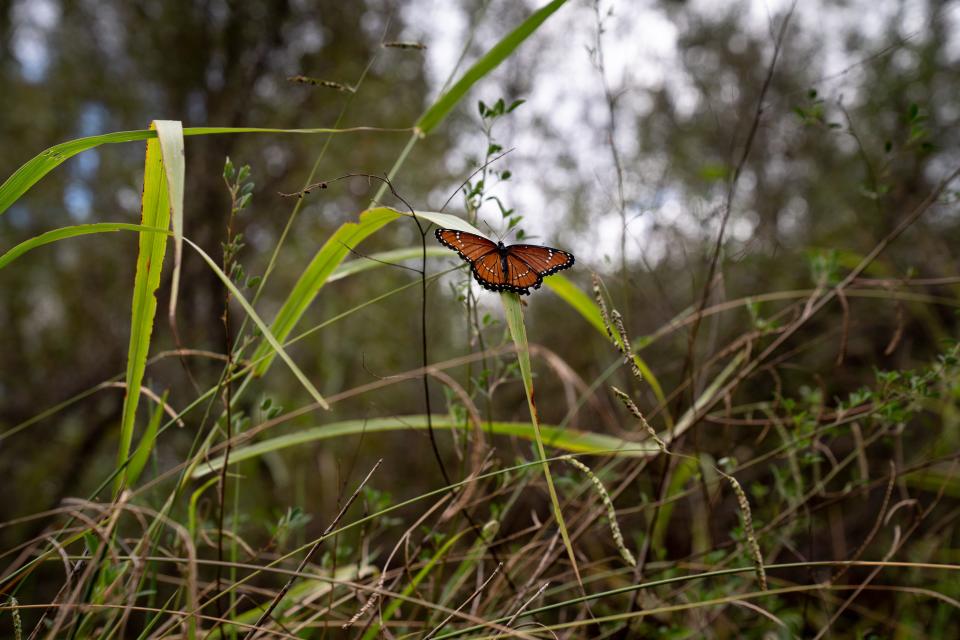
The situation on the San Pedro River is also touch-and-go. The conservancy, the center and other environmental groups like the Sierra Club have identified it as a priority area for protection in Arizona, noting that the Lower San Pedro Basin is second only to the Grand Canyon in size of unfragmented landscapes within Arizona. Archaeologists have uncovered spear points, a mammoth kill site and other evidence of early human civilizations dating back 13,000 years in the region.
Currently, the San Pedro watershed is a flyway for more than 400 species of birds, nearly half of the bird diversity recorded in all of North America, and an astonishing 90 species of mammals. Arizona-based naturalist Ralph Waldt, who authored a book about life on the San Pedro, says the river valley is used by millions of songbirds every year on their migratory journey north. And he can’t think of another area within the 50 states that rivals its mammal diversity.
“These stretches of river with even just a trickle of perennial water, like we have here, are really important for the animal populations in the desert. They provide enough water that birds can hop from one to the next and they have a supply of water when they’re moving from the mountains in Mexico through the edge of the Colorado Plateau,” he said in a video shared by the center.
Eyes on the goal: What do you get when you cross birders with elections? More environmental votes
With recent documented declines in populations of more than 50% of North American bird species and 3 billion fewer birds in the skies than there were 50 years ago, according to reports from the North American Bird Conservation Initiative, it’s not hard to imagine a truly silent spring in San Pedro’s future.
To preempt that fate, the conservancy has worked to reduce agricultural water use, recruited citizen scientists to map river flows during the hottest, driest parts of the year and partnered with the Cochise Conservation and Recharge Network on efforts to boost aquifer levels.
But the center says these efforts won't be nearly enough to save the San Pedro. With representation from Earthjustice and in collaboration with the Lower San Pedro Watershed Alliance, Sierra Club, Tucson Audubon Society, Maricopa Audubon Society and Cascabel Conservation Association, the center has filed two different lawsuits to stop unsustainable groundwater pumping that advocates fear will drain the San Pedro.
In a lawsuit filed January 2019, the center opposed a massive development called the Villages at Vigneto that advertises lush, "Tuscany-style" homes and would risk draining the aquifer connected to the San Pedro's flows to build "28,000 residences, 3 million square feet of commercial space, four golf courses, fountains, lakes and a resort" in the middle of a very non-Tuscany-like desert landscape. The Army Corps of Engineers subsequently suspended the developer's permit.
In its more recent challenge, filed this September, the center has appealed an earlier court ruling that, it says, wrongly credited the Fort Huachuca army base with ending rates of groundwater pumping that still represent the "single greatest contributor to the San Pedro River's demise."
Many of these fights can be traced back to a lack of awareness about how ecosystems and hydrological flows are connected, activists say.
"Arizona law denies the reality of the connection between groundwater and surface water," said Robin Silver, a co-founder of the center. "So it is not possible to stop the groundwater pumpers unless there is a federal nexus. And even when there is like with the San Pedro, the feds refuse to challenge the groundwater pumping that is stealing federal water."
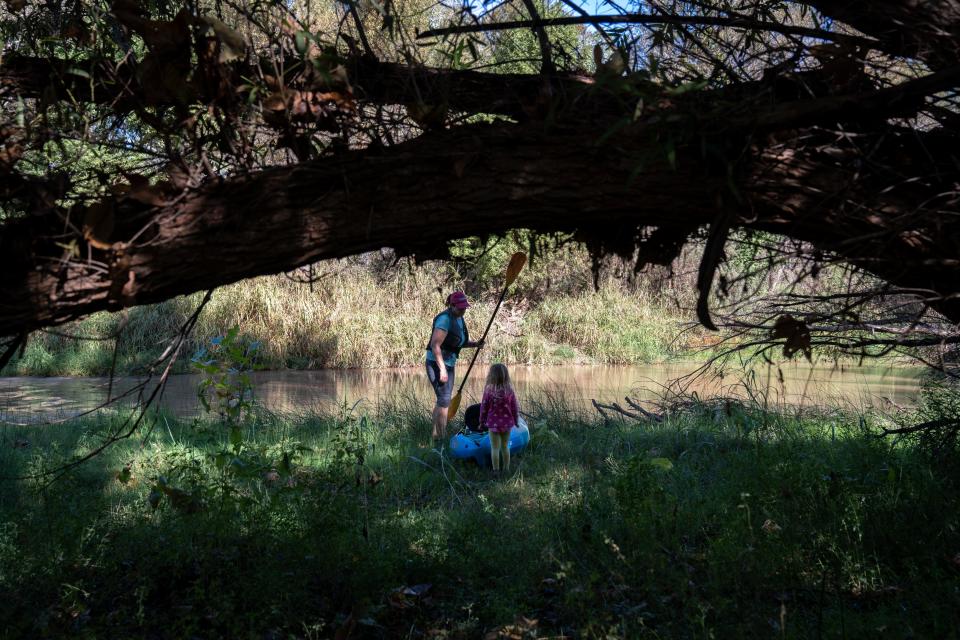
Staying in the green zone
While the middle section of the Verde River that ferried our kayaks through Camp Verde beneath a curtain of grape vines studded with cacophonous cicadas is currently thriving, keeping it that way will likely require Herculean and unrelenting legal and restoration efforts.
Residential development in Yavapai County is progressing with the aid of groundwater pumping that taps directly into the spring-fed headwaters of the Verde River, said Gary Beverly, chair of the Sierra Club's Yavapai Group. He shared a record of water gages in the Paulden area of Yavapai County that shows flows decreasing since 1996, to current levels matching those in the 60s and 70s that are labeled as the result of excessive groundwater pumping at that time in this region north of Prescott.
The state Legislature has also authorized groundwater to be exported from the Big Chino Valley to Prescott to support additional development there, Beverly said. And pumping by agriculture, which uses about 70% of Arizona's water, puts another sizable dent in what remains to flow into the Upper Verde River and beyond, down to Phoenix residents' taps.
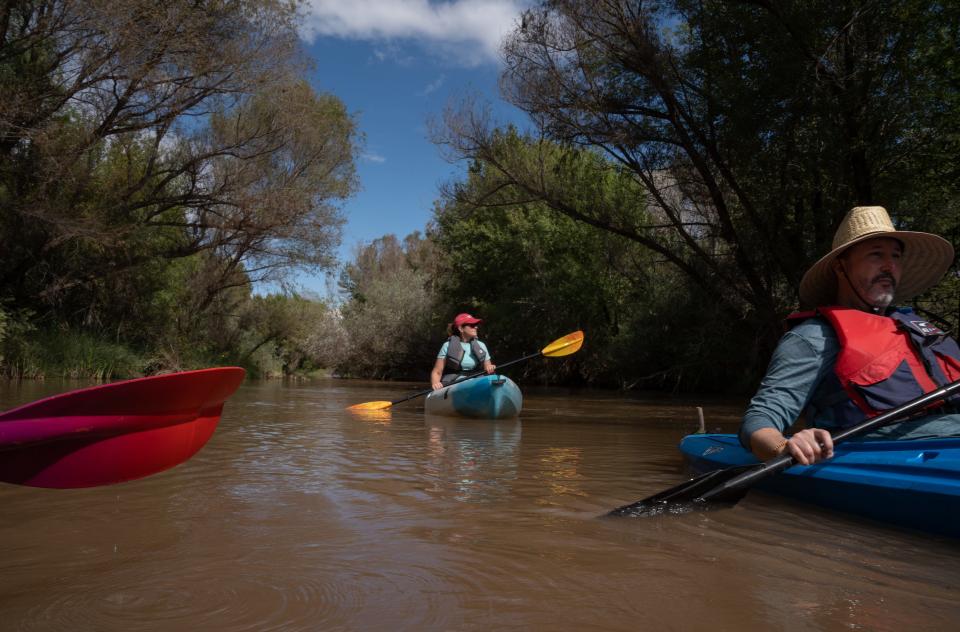
"Right now, the Verde River is in good shape ecologically, though flows are reduced," Beverly said. "But its future is deeply threatened, and the Upper Verde is really deeply threatened. Whenever you remove groundwater from the Big Chino Valley, you are directly removing water from the river. The river is two and a half million years old, but we're on track to dry it up in just a few years. It's death by a thousand straws."
Last year on the Verde: Dry wells, lower flows raise alarm about the Verde River's future
On the middle Verde, about 80 miles downriver from Big Chino Valley, Schonek pulls over and gets out onto the western bank before helping the rest of the kayak flotilla members onto land. She wants to show us where a small dam holds back water so that a pump can suck it 50 feet uphill into an irrigation ditch. From there, a growing number of users in the Verde Valley suck it from the ditch to irrigate their fields or lawns.
“If we could move water rights around, these (restoration) projects would be a lot easier," she says. "Right now, there’s not enough regional planning and too many users (in this area). Some who don’t have water rights; Some who think their water rights are more than they are."
Salt River Project, the provider that delivers Verde River water to much of the Phoenix area, has a vested interest in making sure no one upstream takes more than they should. But Schonek says water use in the Verde Valley is complicated by a long-standing water rights adjudication process advised by the Arizona Department of Water Resources that aims, with no clear end in sight, to determine a property owner’s legal right to surface and underground sources of water.
That gets tricky in a state that does not differentiate between surface and underground sources, regulate well drilling or pumping in non-management areas or employ water masters to deal with local disputes.
"Until we have adjudication, this is not something we can solve," Schonek said. "If Claudia goes out and sees her neighbor stealing water, there’s no one she can call to deal with that. She’d have to file a court case against them herself. In another state, you would call a water master and say 'this person is interfering with my water right.' Arizona doesn’t have water masters. We don’t know if that guy has a water right."
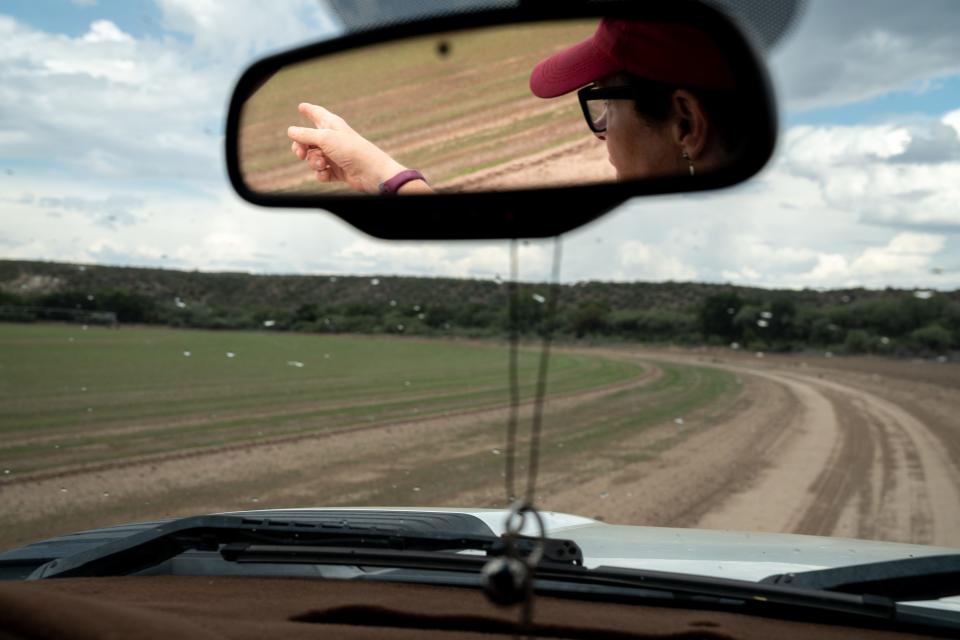
We carry our kayaks around the small dam and launch back onto the river below. After navigating a few small rapids, we pass the spot where West Clear Creek divides the two Hauser farm properties on the east that have been protected through conservation easements secured by the conservancy. Flows from the creek no longer reach the Verde River, due to the effects of climate change and use by new residents upstream.
It could easily become a problem for Claudia Hauser and her family.
"We made a huge commitment with all this land. And farming needs water, always," she says as Schonek points out a beaver on the left.
Hauser wants her 3 year-old granddaughter, Olive, to be able to continue the family legacy of farming in Camp Verde if she wants. That's why they've been taking steps to reduce their reliance on river levels by installing center pivots that use less water to irrigate crops, and working with the conservancy and Friends of the Verde River on programs to fallow fields during hotter, drier months and shift some acreage to more water-efficient crops.
The Verde River Exchange, a water conservation program administered by Friends of the Verde River, awards credits to local users who voluntarily reduce their water consumption and allows residents of businesses in the Verde Valley seeking to lower their "water footprint" to purchase “water offset” credits. Along with grant money from the federal Natural Resources Conservation Service, this funding can help farmers bear the cost of fallowing fields or shifting to more efficient but potentially less valuable crops to save even more water.
More on climate from The Republic: The latest from Joan Meiners at azcentral, a column on climate change that publishes weekly
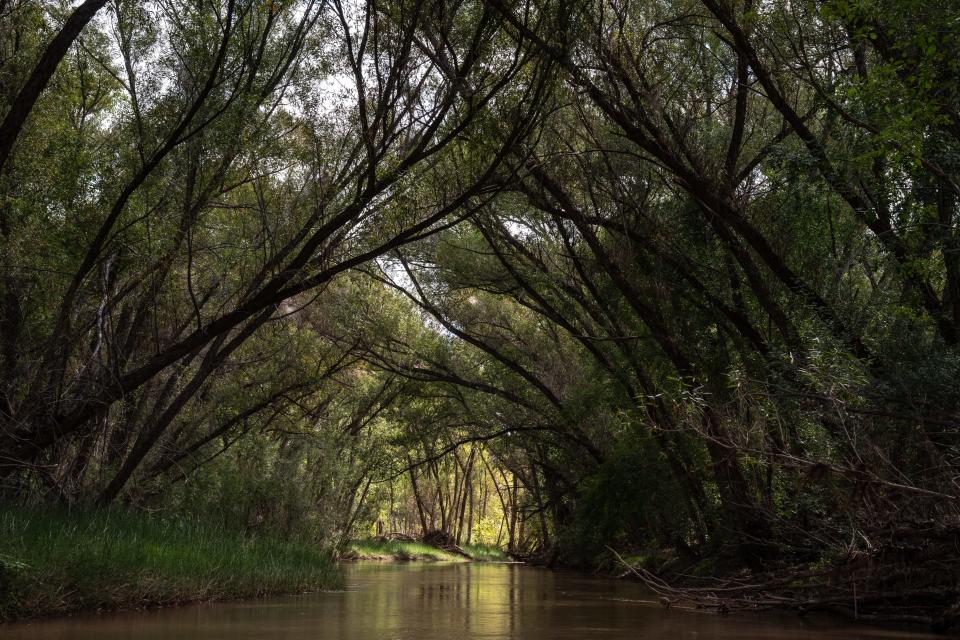
The Hausers have already switched from growing alfalfa to growing a less water-intensive winter barley on a portion of their land. To make that change sustainable, Chip Norton, a local retiree and chair of the Verde Natural Resource Conservation District, agreed to an "encore career" that would create an enduring demand for it.
"We realized that crop conversion wouldn't help save water if there wasn't a market for the crop they wanted to convert to," Norton said. "It turned out that, with some feasibility studies, malting barley or beer barley was a great candidate for that in terms of being marketable for the farmer. So I created a company, which is what I spent most of my time on these days."
Sinagua Malt is identified by Google as an "agricultural service" and by Norton as a "market based water conservation organization." It supplies beer-ready barley to breweries including Arizona Wilderness in Phoenix, Norton's childhood home.
Beverly with the Sierra Club called it a "nice program" but said he thinks it's important to evaluate how much water is actually flowing down the river as a result of such initiatives, which Schonek said the conservancy has not calculated, and to not let small wins obscure the need for ongoing, aggressive and ever-larger efforts on behalf of Arizona's rivers.
Along the final stretch of our October kayak down the middle Verde, the arch of shade-casting branches overhead is completed on our right by trees extending from the west bank too, which has been protected as the Rockin' River Ranch State Park. Storm clouds build as we take turns climbing out onto the muddy east bank and hauling our kayaks up to the truck. Everyone takes turns carrying and loading gear for the return to Camp Verde.
If nothing else, it's clear as the greenery-reflecting Verde that achieving water conservation takes a village.
Joan Meiners is the Climate News and Storytelling Reporter at The Arizona Republic and azcentral. Before becoming a journalist, she completed a doctorate in Ecology. Follow Joan on Twitter at @beecycles or email her at joan.meiners@arizonarepublic.com.
Support climate coverage and local journalism by subscribing to azcentral.com at this link.
This article originally appeared on Arizona Republic: Arizona's Verde River has a chance at water conservation success

